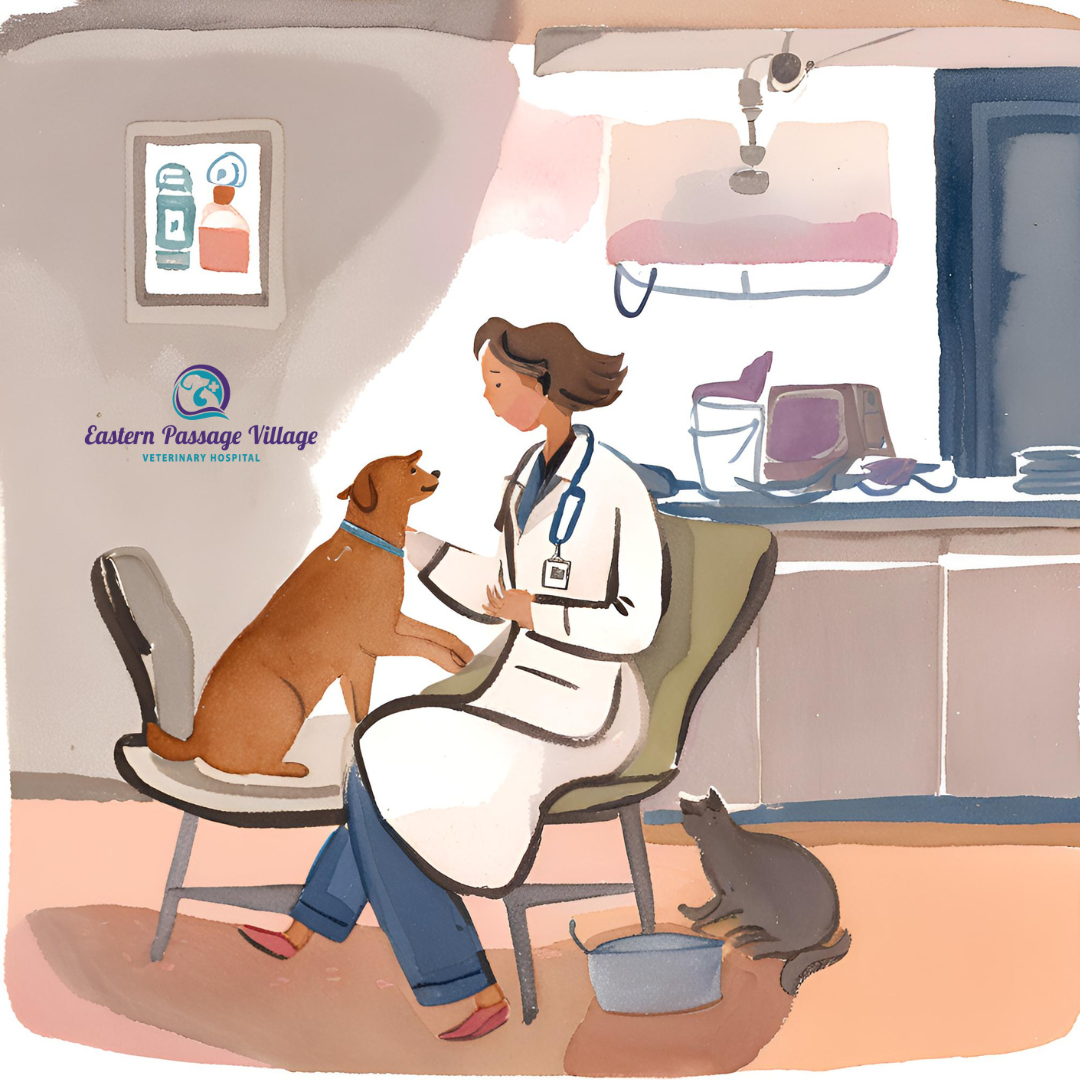By Dr. Emma Bush

It is fall and the kids are back in school! Just like the nervousness that your child may struggle with when going into the new environment of a new class or a new school; your pet too can be anxious when going to the vet. Anything out of the ordinary can cause stress to anyone, human or animal, and a vet visit is certainly outside of your dog or cat’s normal routine.
So what can we do to make our pets less stressed for their vet visit; be it for an annual checkup and vaccines or a sick appointment?
The first and most important thing to know is that fear is a very normal response to the unknown, and much at the vet clinic is unknown or unfamiliar to your pet. Whether this is meeting a new person, being handled in a different way (examination and palpation as opposed to just being petted like they are at home), and even being poked with needles or held in a certain way for diagnostic tests or treatments; nervousness and even fear is not a wrong response. However, when fear goes unchecked and amplifies into distress, discomfort and behavior problems including aggression, this is a problem. Stress can inhibit the body’s normal functions, can decrease rational thinking and can lead to both physical and psychological consequences for our pets. If not addressed appropriately and in a timely manner, these concerns can spiral to the point where our pets can become a danger to both the veterinary team, and to themselves. As such, our goal for our pets and our patients is to do our best to minimize, and ideally prevent as much as possible, nervousness and fear responses.
Part of addressing this is starting at the root, which is acknowledging that fear can sometimes even start before coming to the vet – such as with being put in a carrier (for cats) and/or travel in the car if this is something that your pet does not do on a regular basis.
Tips for your Cat and Dog
For cats, some ways to combat this stress is having their carrier out all of the time and having it as a safe space for your cat. If you only take the carrier out of your storage room or basement one to two times a year to take your cat to the vet, if they see the carrier it will immediately cause their stress levels to go up. However, if we have the carrier out regularly and they can see it as another bed or safe space, the inherent stress associated with the carrier is diminished.
Choosing an appropriate carrier is important as well. You want it to be large enough for your pet to be able to stand up and turn around in, and to not have a slippery floor. Some carriers are helpful at the vet as well as the top can be detached. Many cats do well in these carriers as they do not have to be removed from the carrier and can still stay in their safe space for their exam and, in some cases, for many of their treatments.
Going along with this, if you are bringing multiple cats to the vet, it is important that they each have their own carrier so that they each have their own safe space.
If your cat or dog has a blanket or toy or treat that they love, these can be brought along for the trip and visit as well to bring them comfort and as a source of natural pheromones. Synthetic pheromones like Feliway and Adaptil can also be used – if using these products, it is recommended to utilize them approximately 15-30 minutes prior to your trip.
For dogs and cats alike, the car ride itself can be turned into a positive experience by not having it always associated with the vet. If you are able, take your pet on a short drive where they get treats and then go home with no stressor. This will decrease stress associated with the car or, if able to start from a young age; minimize it altogether.
If your dog or cat gets carsick, avoid feeding them for a few hours prior to the car ride to the vet. If the drive is long enough and your pet suffers severely from motion sickness, speak to your veterinarian about anti-nausea medications to make the travel less distressing to your pet.
We have now addressed the stressors of getting to the vet clinic – but what about stress once we arrive?
Continuing in the vein of setting your pet up for success, if you know that there is anything that typically stresses your pet out, whether that is being around other animals, knocking on doors, slippery floors or more; please let your veterinarian team know in advance so that they can accommodate for your pet. This may include having you come in a separate entranceway with your pet; separate waiting areas for cats and dogs; minimizing wait time (having you wait in the car or parking lot with your pet until they have a room ready for you); use of anti-anxiety pheromones and more.
“Happy Visits” can also be done, where your pet comes to the vet, walks into the exam room or on the scale, gets a treat, interacts with a team member, and then leaves with no exam or treatment performed. For some pets, this can be very helpful and decreasing fear of coming to the vet clinic.
When you do have to come in for an exam, it is important to know that your veterinary team has been trained in reading body language of pets and appropriate handling to minimize stress and maximize safety for all involved. For some pets, this may mean exams targeted to the problem area and minimal handling. For others, it is examining on the ground or in the owners arms and not on the exam table. For some cats, they may choose to hide under a blanket for much of the exam – your veterinarian can work around this. Giving treats (both from the veterinary team and from the owner) is also strongly recommended to minimize stress. It is important to be aware that giving treats to a stressed pet is not rewarding fear behaviors but is serving as a distraction.
Many pets do better having their owners with them; however, some, particularly dogs, can be protective of their owners. In this case, these dogs may do better for their exam and treatments away from their owner.
In some cases, your veterinarian may recommend a muzzle for your pet. This is used to protect not just the veterinary team, but also your pet from becoming a patient with a bite history. I always say that “good dogs wear muzzles”. A muzzle is not a mark of a bad dog, but of a safe situation.
Anti-anxiety medications can also be very helpful for veterinary visits for your dog and your cat. These are medications that you give at home prior to the vet visit to lower anxiety levels for the visit itself. I will often compare this to having a drink of wine before a flight; it does not remove the anxiety, but it can take the edge off. For many patients, this can be very helpful and can facilitate a stress-free or stress-limited exam very effectively.
In some cases, animals may require heavier sedation for a vet visit and/or to get appropriate diagnostics and treatments performed. These animals may have severe stress and anxiety disorders and may benefit from behavioral consultations to best address this fear and anxiety in their lives.
If you have any questions about stress, fear and anxiety for your pet – please speak to your veterinarian.
References Used:
- How to Make Veterinary Visits Less Stressful:
https://veterinarypartner.vin.com/default.aspx?pid=19239&id=10713273 - VCA Fear Free for Dogs:
https://vcacanada.com/know-your-pet/fear-free-for-dogs—overview - VCA Fear Free for Cats:
https://vcacanada.com/know-your-pet/fear-free-for-cats-overview - VCA Reducing the Stress of Veterinary Visits for Cats:
https://vcacanada.com/know-your-pet/reducing-the-stress-of-veterinary-visits-for-cats - Training Your Cat to Use the Carrier:
https://veterinarypartner.vin.com/default.aspx?pid=19239&id=10282561
